Sustainability isn’t just a trend anymore — it’s a business necessity.
From global corporations to small eCommerce sellers, brands across every industry are rethinking how they produce and package products. Consumers want companies that align with their values, and eco-friendly printing is a major part of that conversation.
But what does “sustainable printing” really mean in 2025?
For modern brands, the answer is simple: UV printing.
At CutPrintShip, we’re proud to use UV printing technology not only because it produces exceptional color and quality — but because it does so with minimal environmental impact.
Let’s explore why UV printing is the eco-conscious choice for businesses that want to go green without sacrificing quality, speed, or creativity.
1. The Environmental Problem with Traditional Printing
Traditional printing methods — like offset, solvent, or screen printing — rely on processes that are energy-intensive, chemically wasteful, and pollutant-heavy.

Common Issues in Conventional Printing:
- High VOC emissions: Many solvent-based inks release volatile organic compounds (VOCs) into the air, contributing to smog and health hazards.
- Excess waste: Setup materials (plates, screens, test runs) often end up discarded.
- Long drying times: Require heated dryers, consuming large amounts of electricity or gas.
- Chemical cleanup: Harsh solvents are used to clean screens, rollers, and plates.
Each of these factors adds up — increasing your carbon footprint and hurting your brand’s sustainability goals.
That’s where UV printing stands apart.
2. How UV Printing Reduces Environmental Impact
UV (ultraviolet) printing represents a major leap forward in sustainability. It’s clean, efficient, and remarkably low-waste — all without compromising print quality.
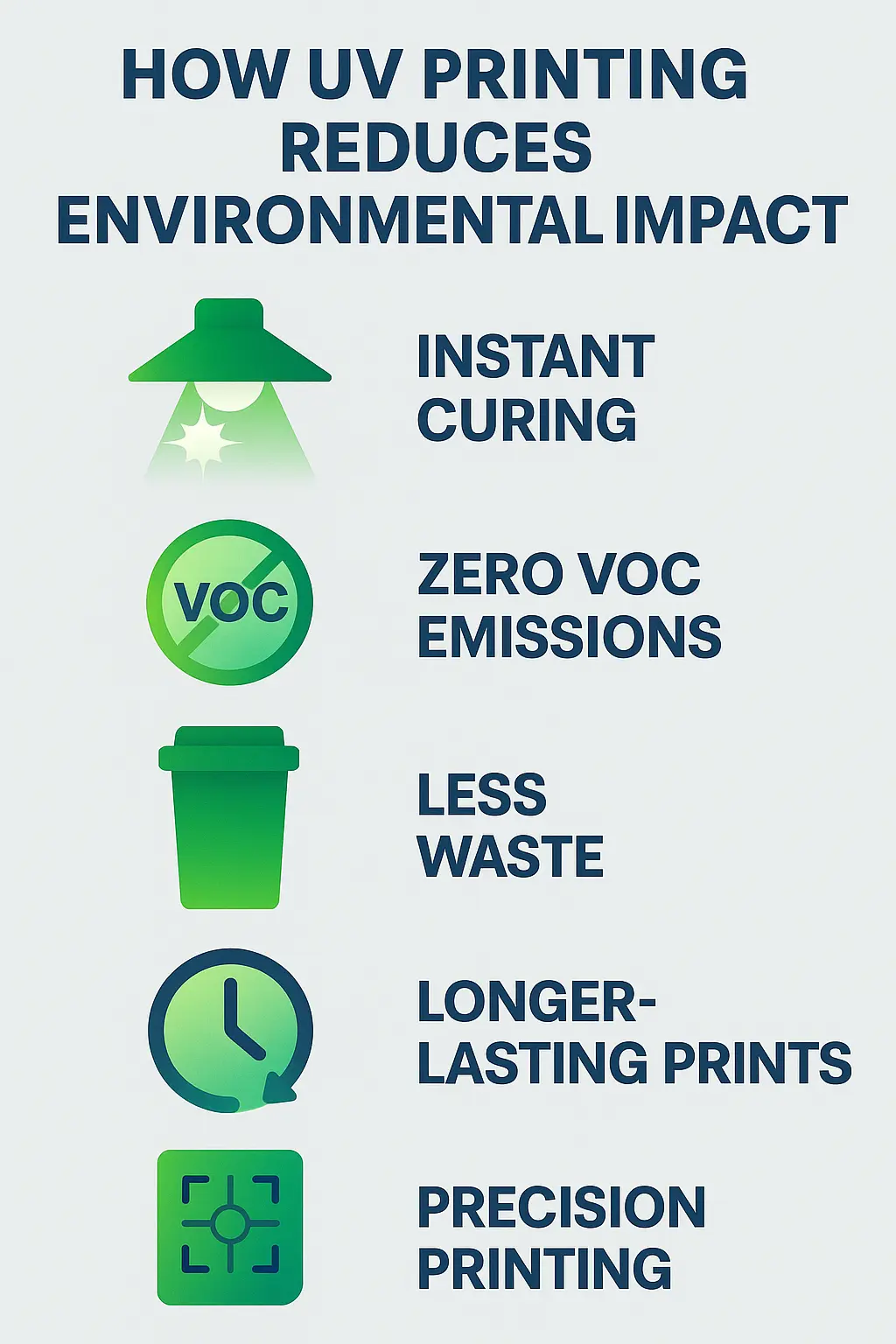
Here’s Why It’s Eco-Friendly:
- Instant Curing = No Drying Energy - Waste - UV inks cure instantly when exposed to ultraviolet light — eliminating the need for heat dryers or fans. That means significantly less energy consumption per print.
- Zero VOC Emissions - UV-curable inks contain no solvents, so they release virtually no volatile organic compounds (VOCs). This reduces both air pollution and health risks for operators.
- Less Material Waste - Because UV printing is digital, there are no plates, screens, or setup materials to discard. You print only what you need, when you need it.
- Longer-Lasting Prints - UV prints are scratch-, fade-, and water-resistant, which extends the life of your products — reducing replacement waste.
- Precision Printing = Fewer Errors - Instant curing also means no smudges, misprints, or rejects — minimizing reprints and wasted material.
At CutPrintShip, these efficiencies translate to cleaner production, faster turnaround, and lower environmental impact for every order we fulfill.
3. Sustainable Inks: The Science Behind UV Technology
The heart of UV printing’s eco-benefits lies in its ink chemistry.
Traditional inks rely on evaporation to dry, releasing harmful solvents in the process. UV inks, however, polymerize — they turn solid under ultraviolet light, bonding instantly to the surface.
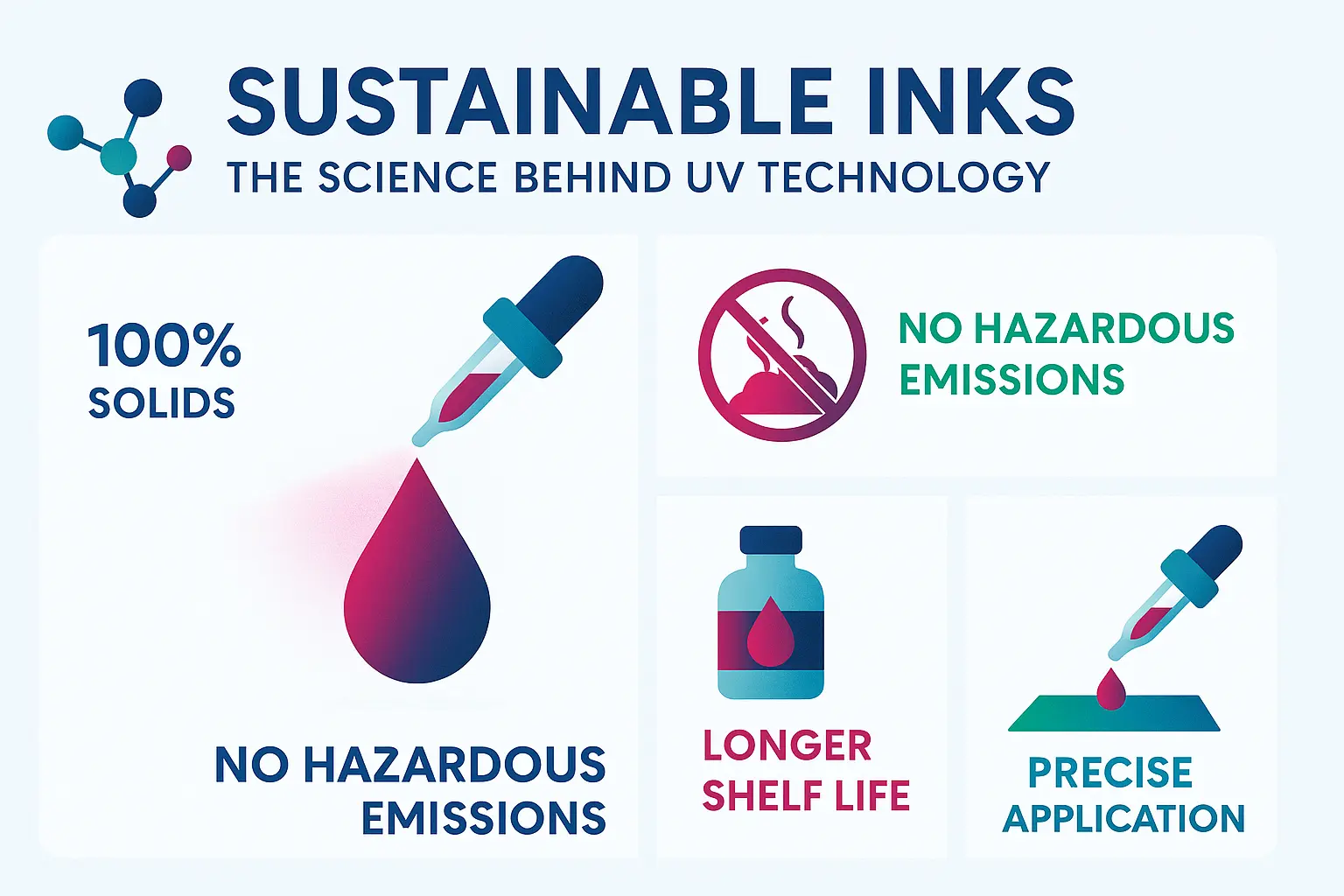
Eco Advantages of UV Inks:
- 100% solids — no water or solvent evaporation
- No hazardous emissions during curing
- Longer shelf life (less ink waste)
- Precise application — only the exact amount of ink is used
The result? Cleaner air, cleaner production, and prints that last longer — a win for both businesses and the planet.
4. Energy Efficiency: LED UV Systems
One of the biggest innovations in UV printing is the shift from traditional mercury lamps to LED-based UV curing.

Why LED UV Is a Game-Changer
- Consumes up to 70% less power than mercury lamps
- Produces less heat, reducing cooling requirements
- Instant on/off functionality — no warm-up time or energy waste
- Longer lifespan, reducing replacement waste
At CutPrintShip, our state-of-the-art LED UV printers run cooler, cleaner, and smarter — aligning perfectly with sustainable production standards.
5. Reduced Waste Through On-Demand Printing
One of the most overlooked aspects of sustainability is production efficiency.
UV printing supports on-demand production, meaning products are printed only when ordered — not in bulk.
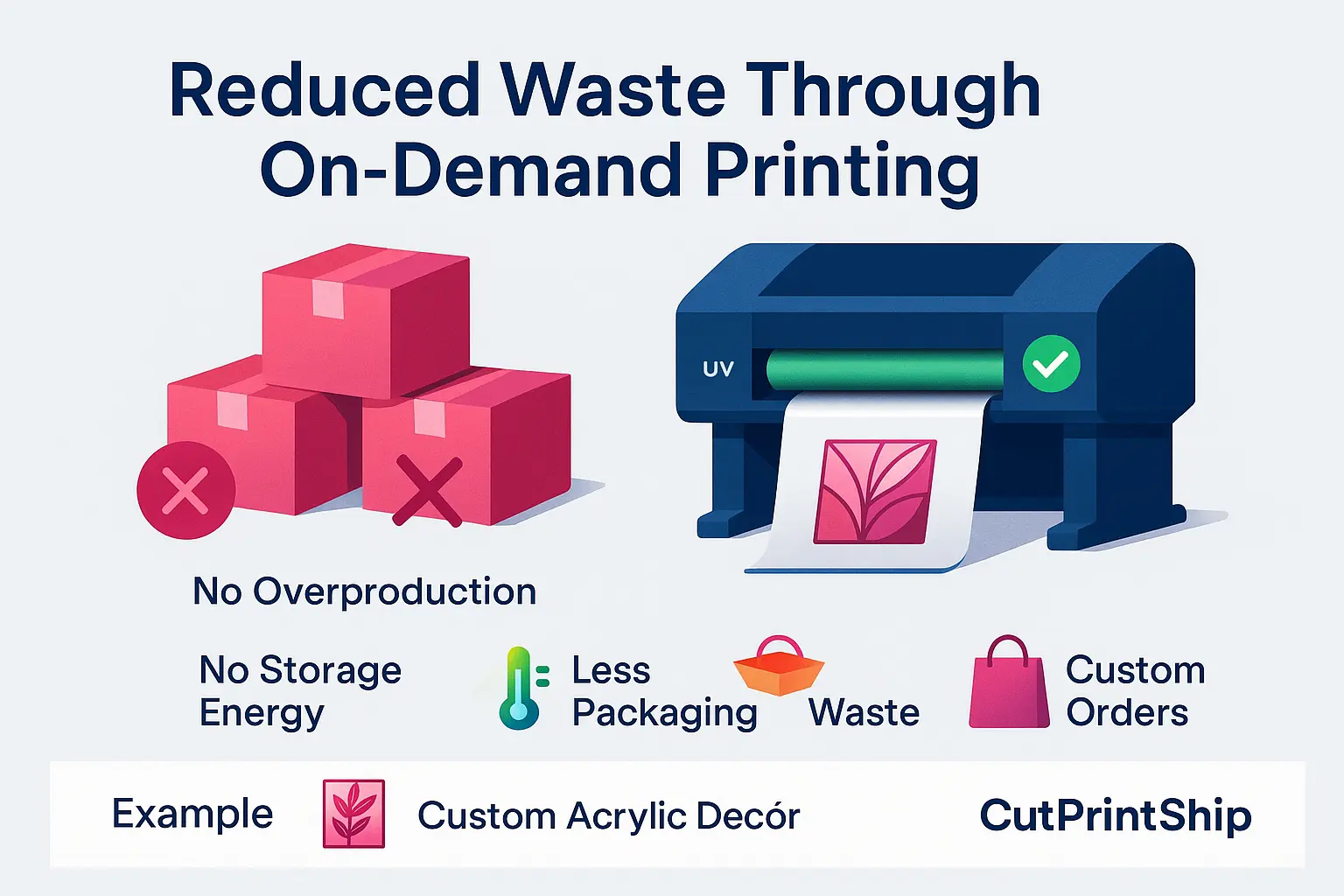
Why This Matters
- No overproduction = no unsold inventory
- No storage energy usage for excess stock
- Less packaging and shipping waste
- Easier customization with zero setup materials
This model dramatically reduces waste across your entire supply chain — from manufacturing to delivery.
EXAMPLE
An online shop selling custom acrylic décor can print one unit per order — avoiding leftover inventory and keeping every product made-to-order.
6. Durable Prints Mean Longer Lifespans
Sustainability isn’t just about how products are made — it’s also about how long they last.
UV printing produces exceptionally durable prints that resist fading, scratching, and moisture. The longer your product lasts, the less frequently it needs to be replaced, reducing waste and total environmental impact.

Perfect For:
- Outdoor signage
- Product labels and packaging
- Décor and promotional displays
Think of durability as invisible sustainability. The longer your print endures, the less you consume over time.
7. Versatility Without Additional Materials
Traditional printing often requires pre-coated or treated materials. UV printing can print directly on virtually any surface — acrylic, wood, glass, metal, plastic, and more — eliminating the need for extra coatings, films, or laminates.
This not only saves resources but also reduces reliance on plastics and chemical adhesives.
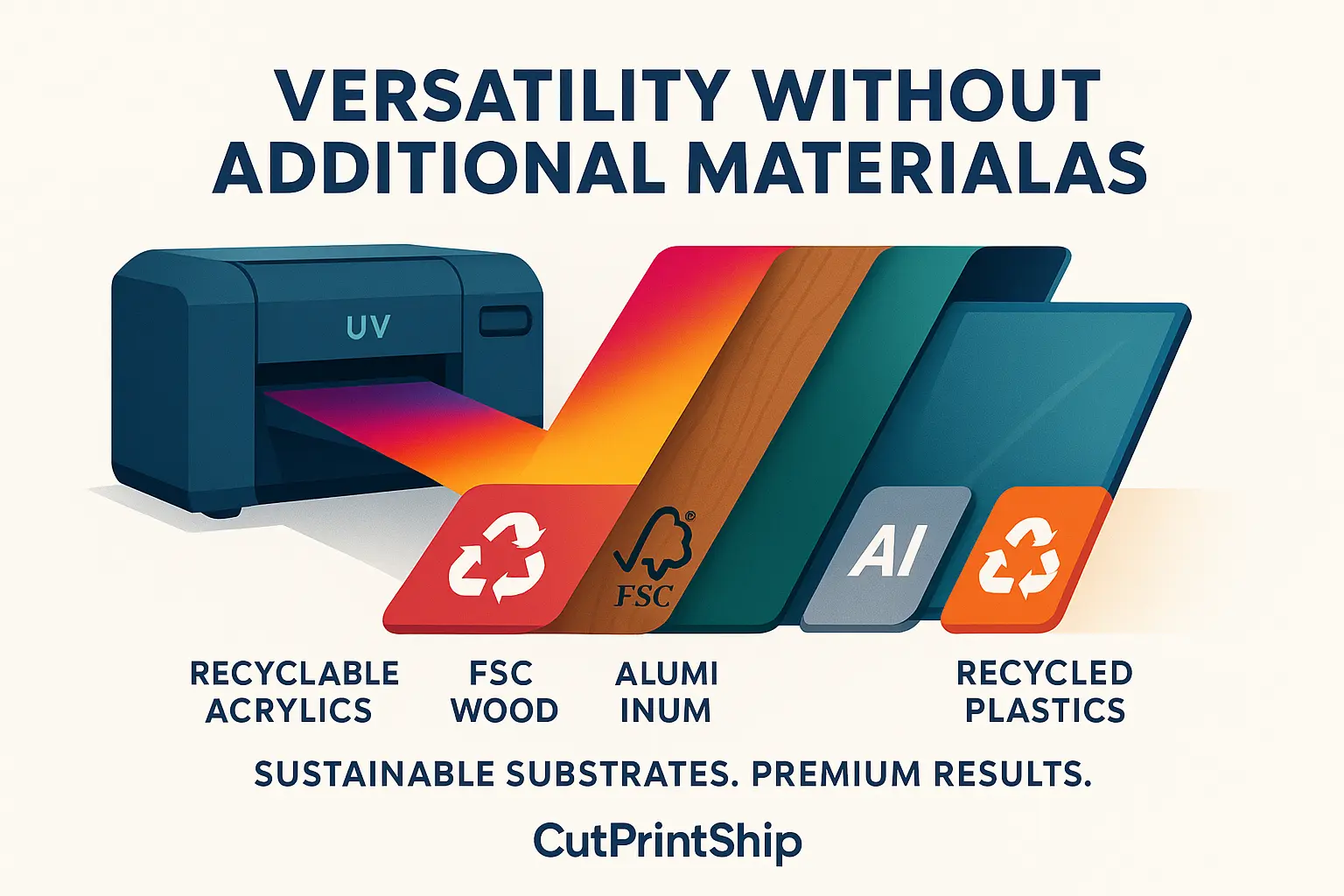
Eco-Friendly Substrate Options Include:
- Recyclable acrylics
- FSC-certified wood
- Aluminum (infinitely recyclable)
- Recycled plastics
At CutPrintShip, we help brands choose substrates that balance aesthetic appeal with environmental responsibility — without compromising print quality.
8. Packaging and Branding: Sustainable Storytelling
Sustainability isn’t just a behind-the-scenes practice — it’s also a powerful marketing message.
Today’s customers don’t just buy products; they buy into brands that care.
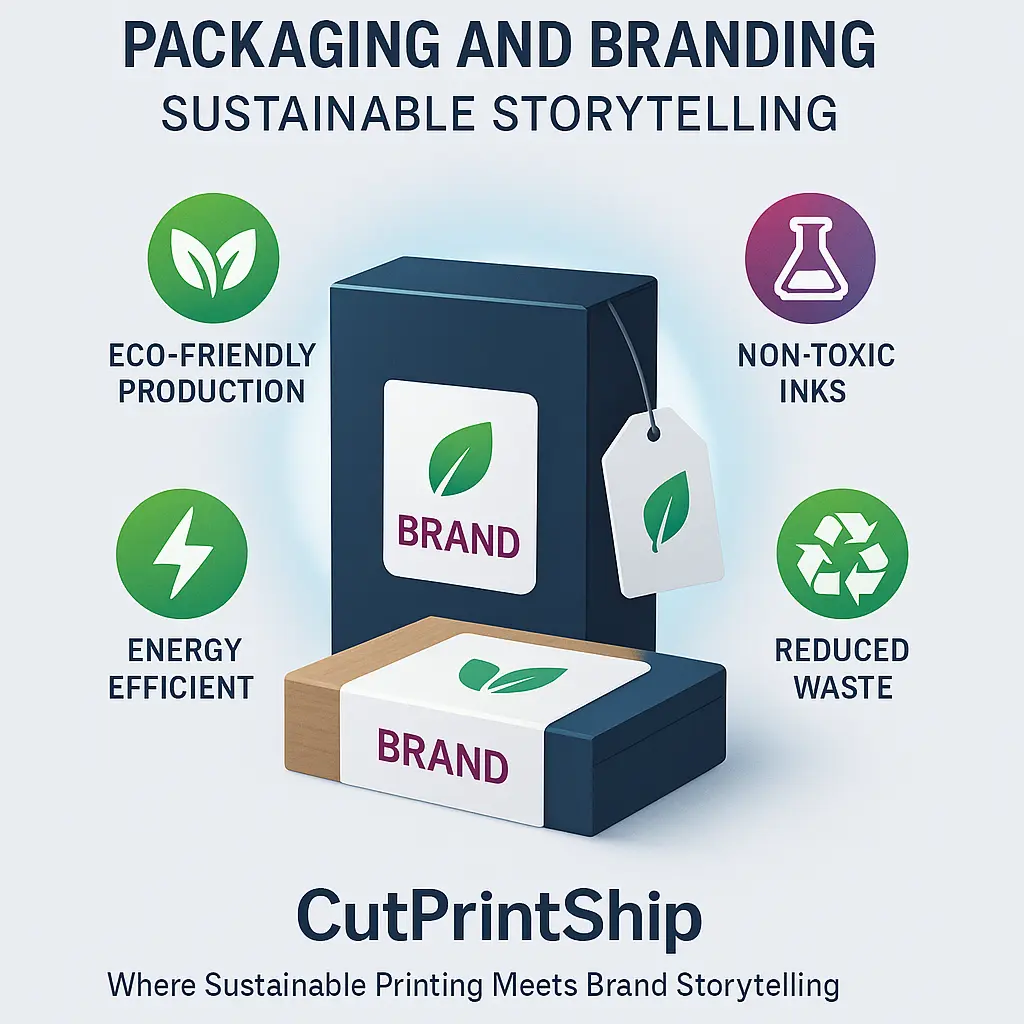
By printing your packaging, signage, and branding materials with UV technology, you can confidently promote:
- Eco-friendly production processes
- Non-toxic inks
- Energy-efficient printing
- Reduced material waste
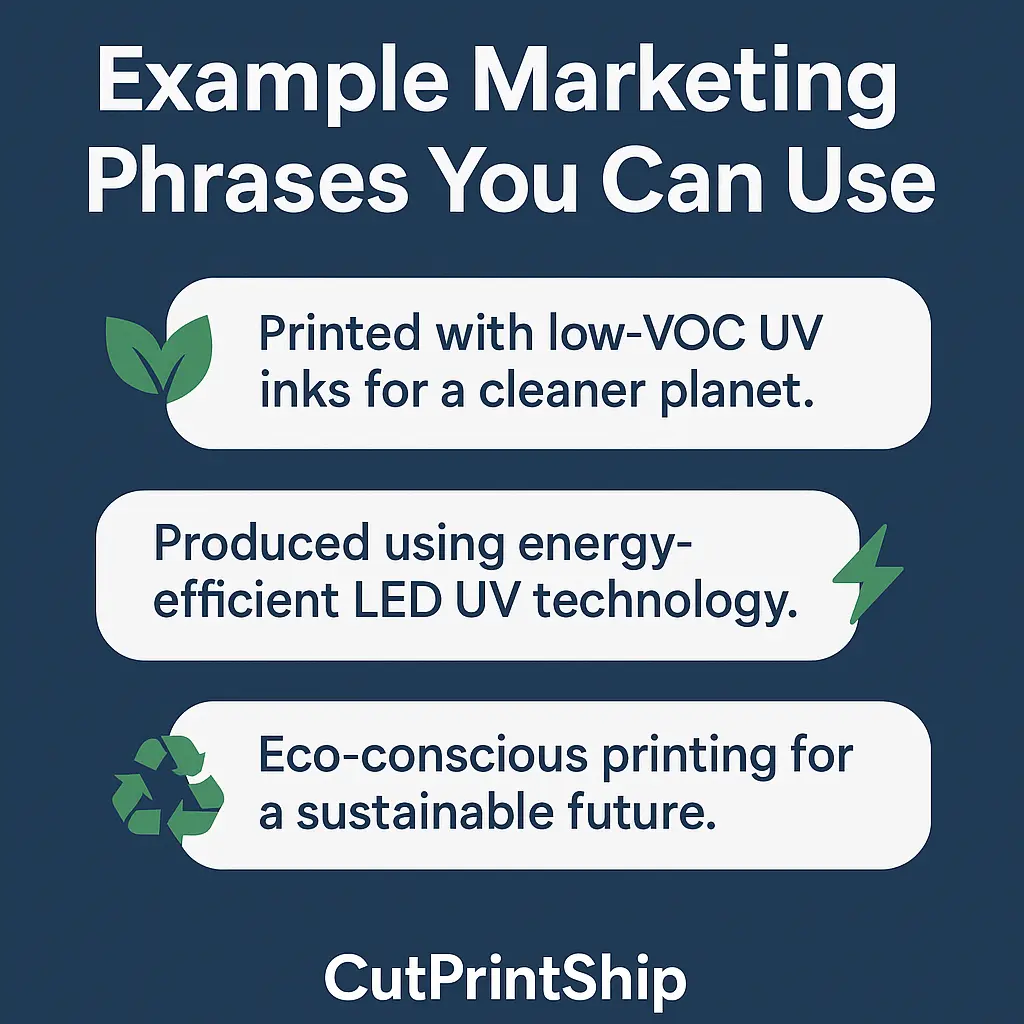
Example Marketing Phrases You Can Use:
- “Printed with low-VOC UV inks for a cleaner planet.”
- “Produced using energy-efficient LED UV technology.”
- “Eco-conscious printing for a sustainable future.”
These simple statements communicate transparency and trust — and can set your brand apart in a crowded market.
9. The Business Case for Sustainable Printing
Choosing eco-friendly production isn’t just about doing the right thing — it’s also good business.

Key Business Benefits
- Brand differentiation: Stand out as a sustainability leader.
- Customer loyalty: Conscious consumers are more loyal to eco-aware brands.
- Compliance readiness: Stay ahead of tightening environmental regulations.
- Cost efficiency: Reduced energy and waste translate to long-term savings.
Sustainability pays off — both ethically and economically.
10. CutPrintShip’s Commitment to Green Printing
At CutPrintShip, sustainability is woven into every stage of our production process.
We’ve invested in UV technology not just for its precision and speed, but for its environmental performance.

Our Green Practices Include:
- VOC-free UV inks and LED curing systems
- On-demand production to minimize waste
- Recyclable packaging materials
- Energy-efficient workflows across all facilities
When you print with CutPrintShip, you’re not just getting quality — you’re partnering with a company that cares about the planet and your brand’s impact.
Conclusion
The future of printing is sustainable, digital, and efficient — and UV printing leads the way.
By combining instant curing, zero emissions, and on-demand flexibility, UV technology allows brands to create stunning products while staying true to their environmental values.
At CutPrintShip, we believe you don’t have to choose between creativity and conscience. With UV printing, you can have both — premium results and a smaller footprint.